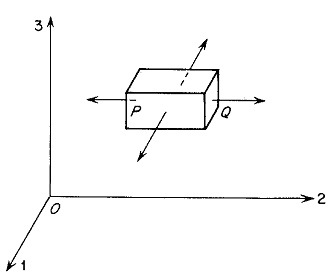| << Chapter < Page | Chapter >> Page > |
since so is a vector.
The unit vector in the direction of is . The derivative of in the direction of is
If is a surface, then is normal to the surface. To prove this, let be a differential distance on the surface. The differential of along is zero for any on the surface. This implies that the scalar product of with any vector on the surface is zero or that has zero component or projection on the tangent plane and thus is normal to the surface. Also, since is normal to the surface, the derivative of is a maximum in the direction normal to the surface.
The symbolic scalar or dot product of the operator and a vector is called the divergence of the vector field. Thus for any differentiable vector field we write
The divergence is a scalar because it is the scalar product and because it is the contraction of the second order tensor .

We will now demonstrate why the operation on a vector field is called the divergence. Suppose that an elementary parallelepiped is set up with one corner at and the diagonally opposite one at , , as shown in Fig. 3.7. The outward unit normal to the face through which is perpendicular to is , whereas the outward normal to the parallel face through is . Suppose is a differentiable flux vector field. We are going to compute the net flux of across the bounding surfaces of the parallelepiped. The value of the normal component of at some point on the two faces perpendicular to the 01 direction are
Thus if denotes the outward normal and is the area of these two faces, we have a contribution from them to the surface integral of
where denotes terms proportional to fourth power of . Similar terms with and will be given by contributions of the other faces so that for the whole parallelepiped whose volume we have
If we let the volume shrink to zero we have
If is a flux, then the surface integral is the net flux of out of the volume. In particular, let be the fluid velocity, which can be thought as a volumetric flux. Then the divergence of velocity is the volumetric expansion per unit volume. A vector field with identically zero divergence is called solenoidal . An incompressible fluid has a solenoidal velocity field. If the flux field of a certain property is solenoidal there is no generation of that property within the field, for all that flows into an infinitesimal element flows out again.
If is the gradient of a scalar function , its divergence is called the Laplacian of .
A function that satisfies Laplace's equation is called a potential function or a harmonic function . An irrotational, incompressible flow field has a velocity that is the gradient of a flow potential. Also, the steady-state temperature field in a homogeneous solid and the steady state pressure distribution of a single fluid phase flowing in porous media are solutions of Laplace's equation. In two dimensions the solutions of Laplace's equation can be found through the use of complex variables.

Notification Switch
Would you like to follow the 'Transport phenomena' conversation and receive update notifications?